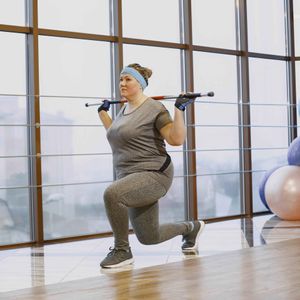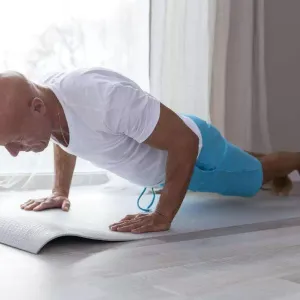

Our Review Process
Our articles undergo extensive medical review by board-certified practitioners to confirm that all factual inferences with respect to medical conditions, symptoms, treatments, and protocols are legitimate, canonical, and adhere to current guidelines and the latest discoveries. Read more.
Our Editorial Team
Shifa Fatima, MSc.
Author
Dr. Apoorva T, MHM.
MEDICAL ADVISOR
How To Fight Diabetes With Home Exercises
Prediabetes physical exercise is crucial to carry out to fight diabetes. Workouts help to reduce blood sugar levels and lower blood pressure in the body. Exercises energize the body and activate it, increase the strength and stamina of a person, and make them feel enthusiastic. People with diabetes can benefit a lot from home exercises as they help improve their condition. Diabetes can be controlled to a large extent by implementing positive and healthy lifestyle changes. It can be overwhelming to start physically working out at first, but there are a set of beginning exercises that can be carried out to get the hang of it.
Table of Contents
Strength Exercises to Help Prevent Prediabetes
People with diabetes have the potential to benefit a lot from doing physical strength exercises. These prediabetes physical exercises help lose weight, reduce the level of blood pressure in the body, help maintain a healthy heart, and help lower the level of HDL cholesterol and triglycerides. Strength exercises also allow healthy cholesterol levels to rise and build up strength in the muscles and bones. For people with diabetes, strength exercises help lower the amount of blood glucose levels and increase the body's production of insulin to regulate sugar levels.
All types of strength exercises, such as aerobic, resistance, or a combination of these exercises, benefit people a lot—resistance training and aerobics help reduce the body's insulin resistance. Also, regular walking reduces the chances of heart attacks or strokes in people with diabetes. Also read about how to prevent diabetes.
Wall Push-Ups
Prediabetes physical exercise can be of many types, and one of them is wall push-ups. Wall push-ups are a type of push-ups that ease the pressure on a person's wrists while doing regular push-ups. Wall push-ups are carried out through the same muscle work without burdening the wrists. Here is the way to do wall push-ups:
- Firstly, a person has to place their hands within a gap that should be equal to the width of their shoulders, firmly on a wall.
- Secondly, the person has to ensure that there is a gap between the body and the hands placed against the wall.
- Thirdly, the elbows should be close to the body, and then they should be lowered until the person’s nose is touching the wall.
- This motion should be repeated in sets.
As the body becomes more comfortable with the exercise, the person should try and carry out normal push-ups if their body allows them to.
Squats
Squatting is an exercise where the person sits in a low or crouching position with their legs close to their body. Squatting is a prediabetes physical exercise that mainly focuses on increasing the strength of the legs and the core of a person’s abdomen. Here is the way to do squats:
- A person needs to stand with a gap between their feet which should be equal to the width of their hips, and the weight of the body should be concentrated on the feet of the person.
- The chest should be held high, and the knees should be bent to lower the whole body.
- The body can be easily balanced by placing the hands in the air or can also be placed on the hips.
- The body should be lowered as much as it can so that the knees create a 90-degree angle.
- This motion should be repeated in sets, taking one at a time and giving oneself the time to catch a breath.
As the body starts to get the hang of the exercise, a person can also try to lift the knees between every squat.
Arm Circles
Another type of prediabetes physical exercise is arm circles. Arm circles are defined as small, repetitive arm movements that help a ton and stretch muscles of the arms and shoulders. Here is the way to carry out arm circles:
- A person should stand with a gap between their feet, which should equal the width of their hips by extending their arms. The body of the person should form a T-shape.
- The arms should be rotated while keeping the shoulders straight.
- The motion should be changed after every 30 seconds.
As the body starts to get comfortable, a light amount of weight should be added to increase and test the strength of the arms.
Lunges
Lunges are one of the most popular and highly effective prediabetes physical exercises, which help increase the body's strength. Lunges involve doing a sudden forward body thrust with a little pressure. Here is the way to do lunges:
- A person should keep their hands on their hips, and the feet should be closely knitted together.
- The right foot should be moved forward while bending the left knee, and the right leg should make a 90-degree angle, while the left knee should be almost touching the ground.
- After making this motion, the right foot should be placed back in its original position.
- Then, the left foot should be moved forward, and the motion is to be repeated.
As the strength of the body starts to increase, some light weight should be added after every lunge to strengthen the core and the legs. A person should have a minimum goal of doing three sets of lunges.
Cardiovascular Exercises to Help Prevent Prediabetes
Aside from prediabetes physical exercises, there are cardiovascular exercises carried out to help in aiding prediabetes and diabetes. Here are some cardiovascular exercises:
- Walking helps keep the body active and helps in burning calories, increases digestion, etc.
- Running and jogging are also widely popular cardio exercises that help aid pre diabetic symptoms.
A combination of cardiovascular exercises and prediabetes physical exercise helps keep a person fit.
Bottomline
The simple home exercises mentioned above are easy to do and deliver effective results in reducing the impact of symptoms of prediabetes. Diabetes is chronic, but the negative impact can be prevented by carrying out these exercises. In addition to these prediabetes physical exercises, people should constantly check their blood sugar levels. Also know about prediabetes diet.
References
- https://www.webmd.com/diabetes/ss/slideshow-exercises-diabetes
Disclaimer
This website's content is provided only for educational reasons and is not meant to be a replacement for professional medical advice. Due to individual differences, the reader should contact their physician to decide whether the material is applicable to their case.







